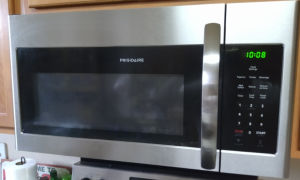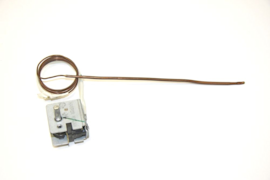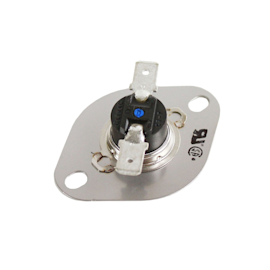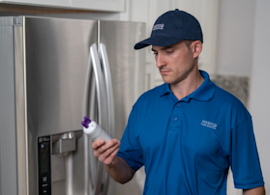How to replace a microwave fuse


When your microwave won’t power up or won’t heat, you may rightly suspect that a fuse is blown.
If the microwave won’t power up at all (the control panel doesn’t light up), the house fuse for the microwave may be blown or the house circuit breaker for the microwave may have tripped. (Older homes use fuses to protect appliance electrical outlet circuits and newer homes use circuit breakers.) Resetting the house circuit breaker or replacing the house fuse may restore power to your microwave.
An internal fuse inside the microwave case can also prevent the microwave oven control from powering up.
When the microwave has power but won’t heat or runs but won’t heat, a blown fuse is often the culprit causing the problem.
How do I know if my microwave fuse is blown?
To see whether your microwaves house fuse has blown (or its circuit breaker has tripped), unplug the microwave and plug a small electrical device such as a lamp or night light into the outlet to check for power.
If the small electrical device doesn’t get power through the electrical outlet, then the microwave house fuse is likely blown (or its circuit breaker likely tripped). Replace the fuse or reset the tripped house breaker to restore power to the microwave’s electrical outlet.
If the small electrical device powers up (indicating that the microwave’s electrical outlet has power) but the microwave doesn’t work, then a blown internal microwave fuse may be keeping the microwave from powering up or heating.
Does a microwave need a special fuse?
Microwave ovens do require specific internal fuses. A microwave typically has several different types of fuses that perform various functions. The wiring diagram and replacement parts diagram for your microwave shows exactly which fuses your model has.
Here are the different types of internal fuses that you’ll find in many microwave ovens.
Line fuse. The line fuse blows when excessive electrical current flows through the microwave because of an electrical short in wiring or a microwave part. The microwave will be completely dead when the line fuse blows.
Magnetron thermostat or fuse. The magnetron produces the high-energy waves that heat food inside the microwave oven cavity. When the magnetron overheats, the magnetron thermostat trips or the magnetron fuse blows to prevent fire and electrical shorts inside the microwave. The magnetron thermostat resets when it cools down on some microwave models. On some microwaves, the magnetron thermostat is non-resettable and must be replaced once it trips. A magnetron fuse isn’t resettable so it needs to be replaced after it blows.
Cavity thermostat or cavity thermal fuse. The cavity thermostat or cavity thermal fuse rests on the top of the microwave’s oven cavity. The cavity thermostat (or fuse) trips when food inside the microwave oven cavity overheats and catches on fire. The cavity thermostat is resettable on some models so you can resume using the microwave once the oven cavity cools down and the thermostat resets. If the cavity thermostat is non-resettable or the microwave has a cavity thermal fuse, you’ll need to replace the component after it blows.
What fuse to use in a microwave?
To find out which fuse to use in a microwave, look up the part on the microwave parts list diagram for your specific model. Order the replacement part specifically listed for your model once you’ve located the fuse on the parts diagram.
Although you can order a replacement fuse for your microwave, we strongly advise against attempting to replace an internal fuse yourself. Attempting DIY repairs on a microwave is extremely dangerous. The Consumer Product Safety Commission Safety Alert on DIY microwave repair warns against attempting microwave oven repairs because of the extreme risk of electrocution. Microwaves contain high voltage capacitors that retain a lethal amount of electricity even when the microwave is unplugged from its power source.
Don’t risk your life or health by attempting to replace an internal microwave fuse on your own. Have a service technician replace the fuse or replace the microwave.
Most common symptoms to help you fix your wall oven
Choose a symptom to see related wall oven repairs.
Main causes: bad oven door lock assembly, faulty electronic control board, wiring failure…
Main causes: broken broil element, faulty broil burner igniter, control system failure…
Main causes: broken bake element, bad bake burner igniter, tripped thermal switch, control system failure…
Main causes: faulty oven temperature sensor, control system problem, weak burner igniter, damaged oven element…
Main causes: lack of electrical power, bad electronic control board, faulty oven control thermostat…
Main causes: lack of gas supply, broken igniter, tripped circuit breaker, broken oven element, tripped thermal fuse, con…
Most common repair guides to help fix your wall oven
These step-by-step repair guides will help you safely fix what’s broken on your wall oven.

How to replace a wall oven door outer glass panel
Learn how to replace a damaged outer window panel on your wall oven door with these step-by-step instructions. …

How to replace a wall oven control thermostat
Get your oven temperature under your control by replacing a faulty oven control thermostat.…

How to replace a wall oven thermal fuse
The thermal fuse trips to prevent the over from excessively overheating. The oven won't heat again until you replace the…
Effective articles & videos to help repair your wall oven
Use the advice and tips in these articles and videos to get the most out of your wall oven.

Get tips on completing essential holiday cleaning tasks to brighten your home.…

Learn about all the convenient features on our Sears PartsDirect website that make your parts purchases easier.…

Get answers to frequently asked questions about Sears and Sears PartsDirect.…
